Failure of Starbucks in Australia Report
VerifiedAdded on 2022/09/08
|11
|3043
|25
AI Summary
Contribute Materials
Your contribution can guide someone’s learning journey. Share your
documents today.
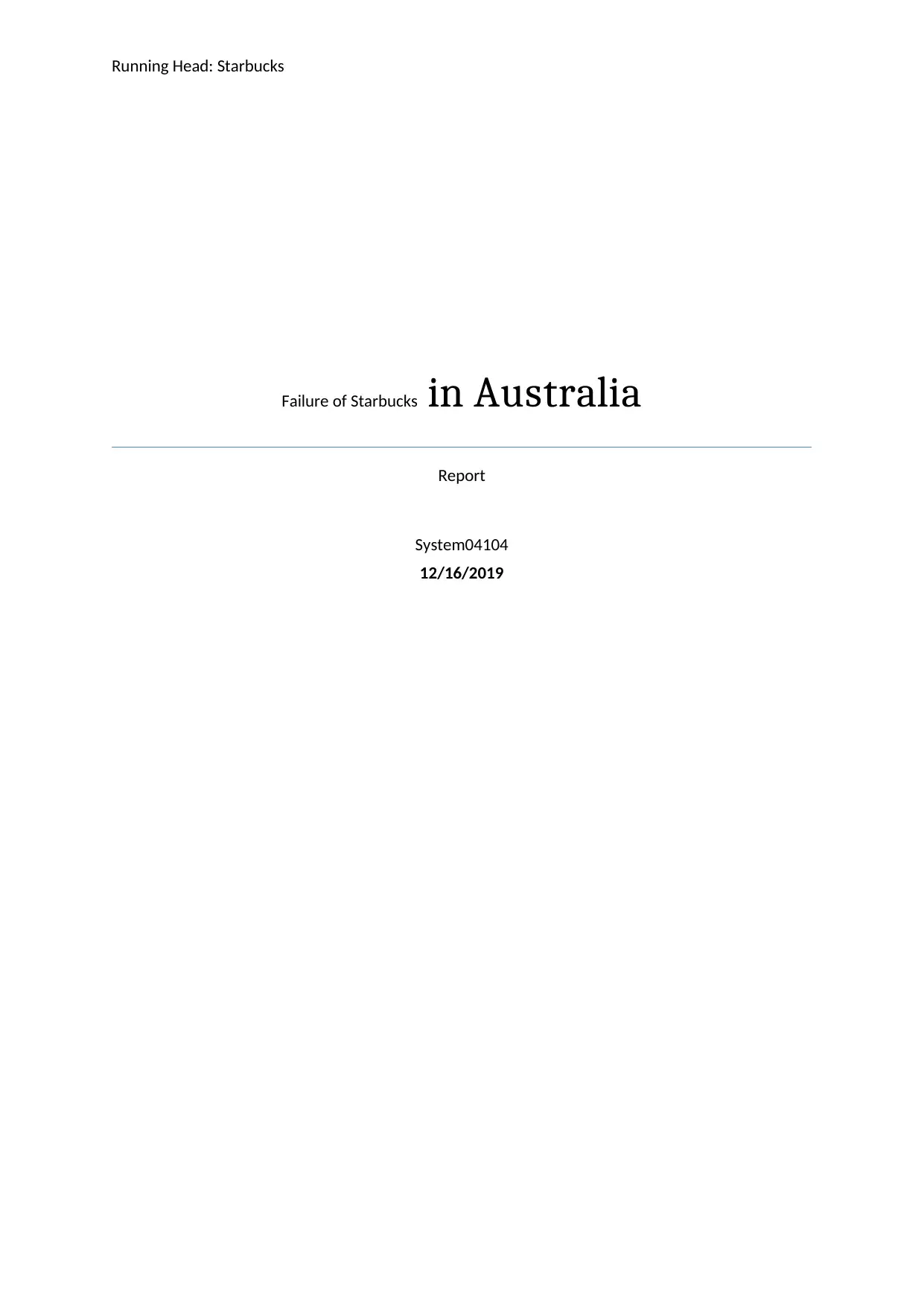
Running Head: Starbucks
Failure of Starbucks in Australia
Report
System04104
12/16/2019
Failure of Starbucks in Australia
Report
System04104
12/16/2019
Secure Best Marks with AI Grader
Need help grading? Try our AI Grader for instant feedback on your assignments.
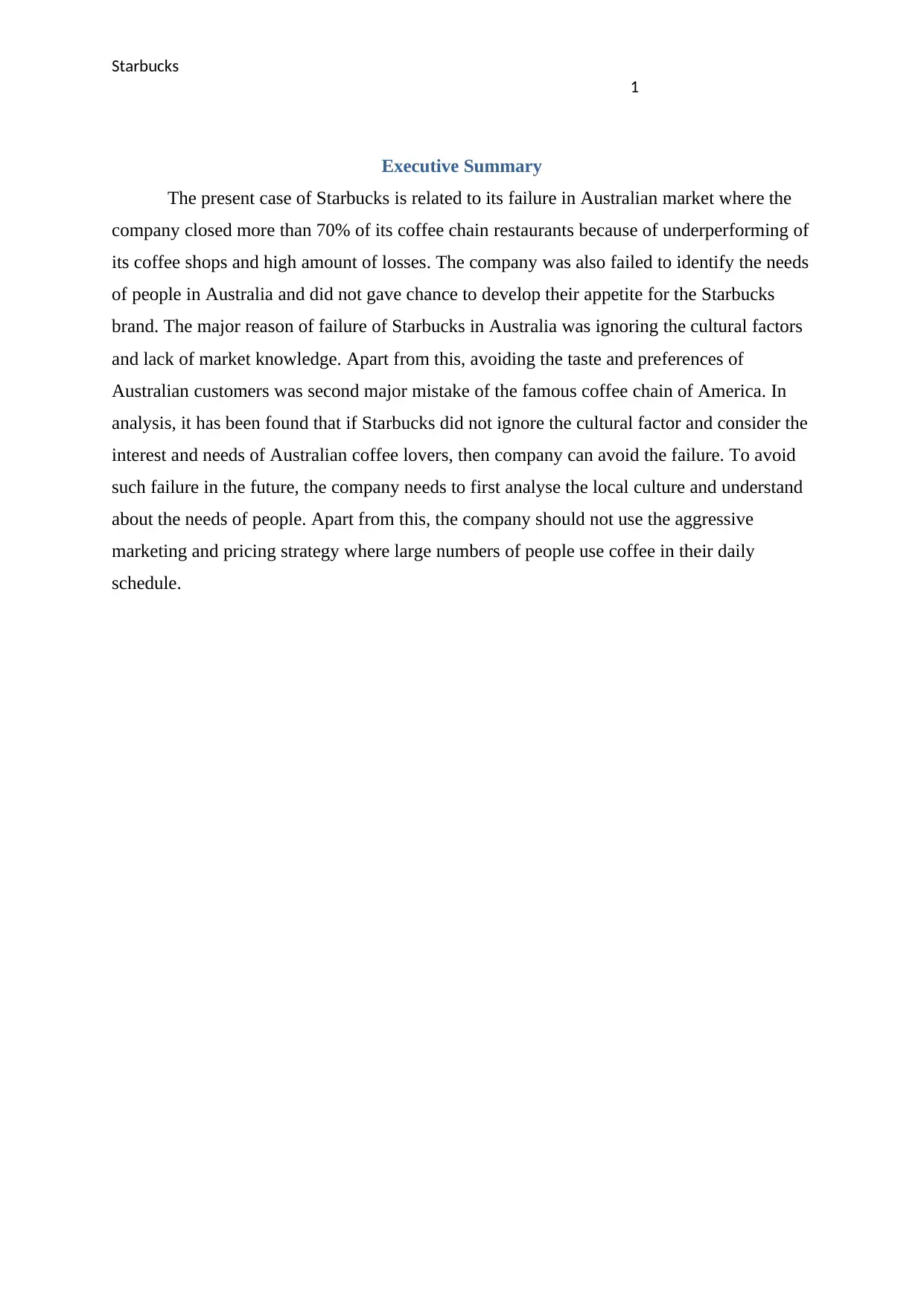
Starbucks
1
Executive Summary
The present case of Starbucks is related to its failure in Australian market where the
company closed more than 70% of its coffee chain restaurants because of underperforming of
its coffee shops and high amount of losses. The company was also failed to identify the needs
of people in Australia and did not gave chance to develop their appetite for the Starbucks
brand. The major reason of failure of Starbucks in Australia was ignoring the cultural factors
and lack of market knowledge. Apart from this, avoiding the taste and preferences of
Australian customers was second major mistake of the famous coffee chain of America. In
analysis, it has been found that if Starbucks did not ignore the cultural factor and consider the
interest and needs of Australian coffee lovers, then company can avoid the failure. To avoid
such failure in the future, the company needs to first analyse the local culture and understand
about the needs of people. Apart from this, the company should not use the aggressive
marketing and pricing strategy where large numbers of people use coffee in their daily
schedule.
1
Executive Summary
The present case of Starbucks is related to its failure in Australian market where the
company closed more than 70% of its coffee chain restaurants because of underperforming of
its coffee shops and high amount of losses. The company was also failed to identify the needs
of people in Australia and did not gave chance to develop their appetite for the Starbucks
brand. The major reason of failure of Starbucks in Australia was ignoring the cultural factors
and lack of market knowledge. Apart from this, avoiding the taste and preferences of
Australian customers was second major mistake of the famous coffee chain of America. In
analysis, it has been found that if Starbucks did not ignore the cultural factor and consider the
interest and needs of Australian coffee lovers, then company can avoid the failure. To avoid
such failure in the future, the company needs to first analyse the local culture and understand
about the needs of people. Apart from this, the company should not use the aggressive
marketing and pricing strategy where large numbers of people use coffee in their daily
schedule.
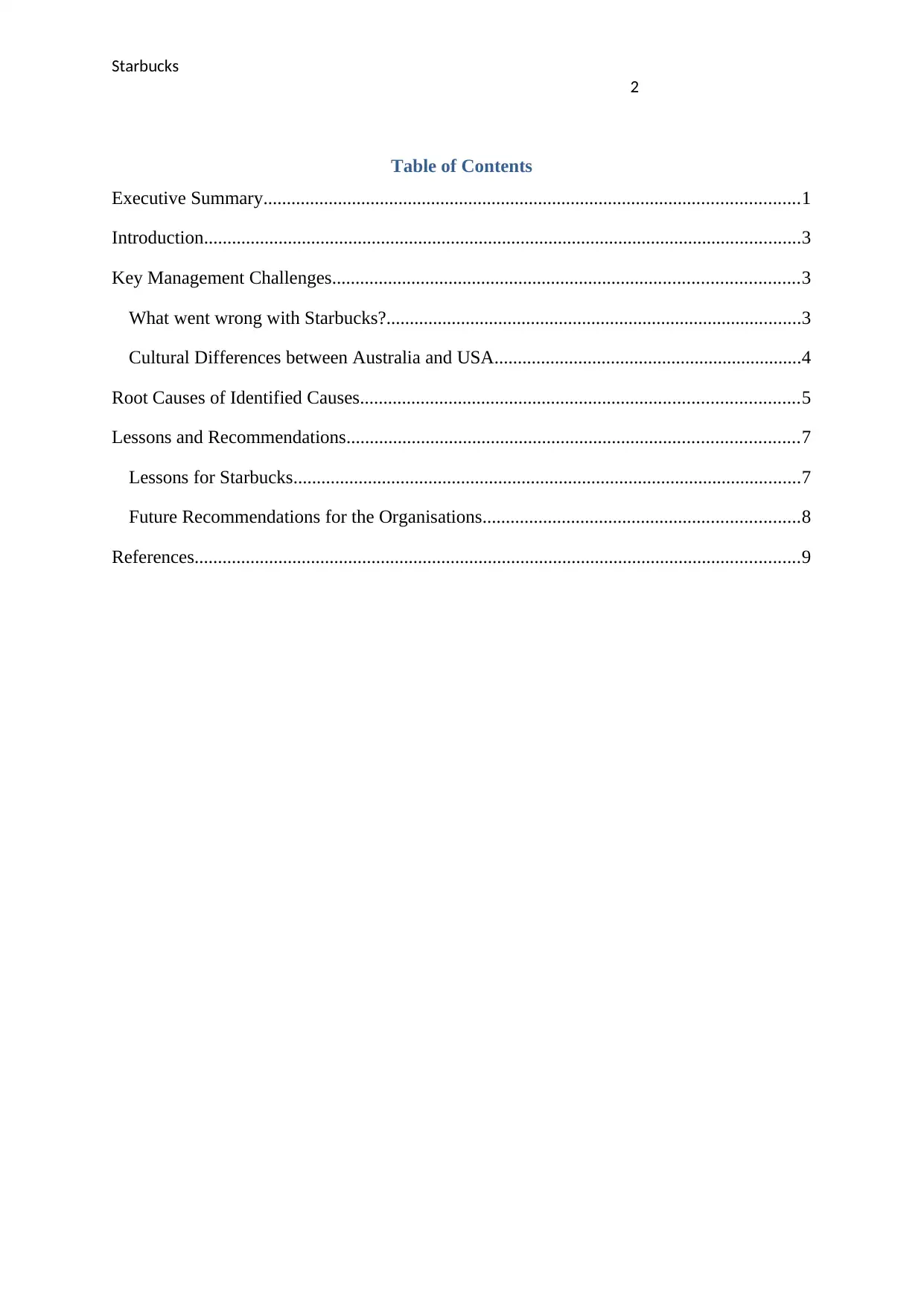
Starbucks
2
Table of Contents
Executive Summary...................................................................................................................1
Introduction................................................................................................................................3
Key Management Challenges....................................................................................................3
What went wrong with Starbucks?.........................................................................................3
Cultural Differences between Australia and USA..................................................................4
Root Causes of Identified Causes..............................................................................................5
Lessons and Recommendations.................................................................................................7
Lessons for Starbucks.............................................................................................................7
Future Recommendations for the Organisations....................................................................8
References..................................................................................................................................9
2
Table of Contents
Executive Summary...................................................................................................................1
Introduction................................................................................................................................3
Key Management Challenges....................................................................................................3
What went wrong with Starbucks?.........................................................................................3
Cultural Differences between Australia and USA..................................................................4
Root Causes of Identified Causes..............................................................................................5
Lessons and Recommendations.................................................................................................7
Lessons for Starbucks.............................................................................................................7
Future Recommendations for the Organisations....................................................................8
References..................................................................................................................................9
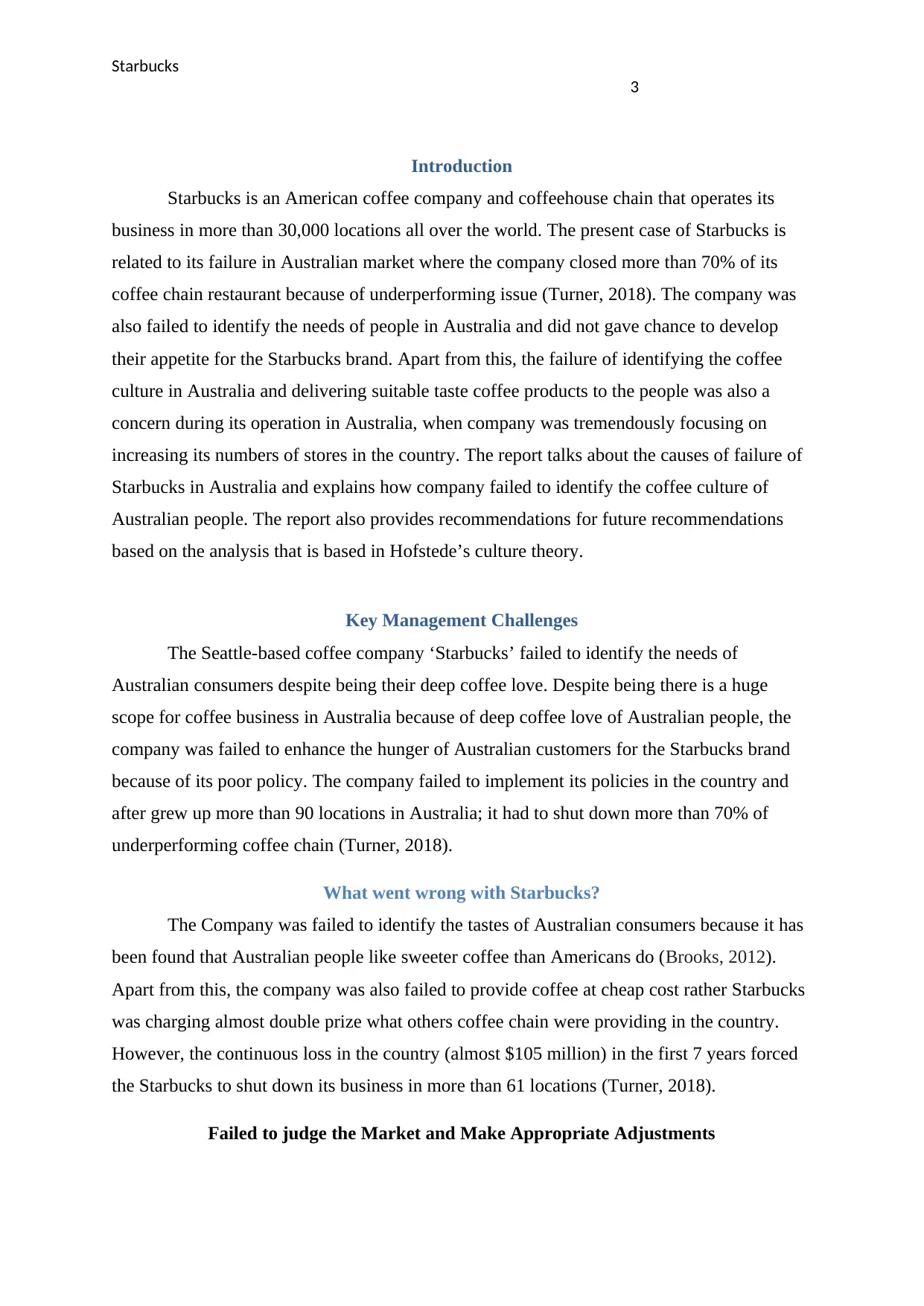
Starbucks
3
Introduction
Starbucks is an American coffee company and coffeehouse chain that operates its
business in more than 30,000 locations all over the world. The present case of Starbucks is
related to its failure in Australian market where the company closed more than 70% of its
coffee chain restaurant because of underperforming issue (Turner, 2018). The company was
also failed to identify the needs of people in Australia and did not gave chance to develop
their appetite for the Starbucks brand. Apart from this, the failure of identifying the coffee
culture in Australia and delivering suitable taste coffee products to the people was also a
concern during its operation in Australia, when company was tremendously focusing on
increasing its numbers of stores in the country. The report talks about the causes of failure of
Starbucks in Australia and explains how company failed to identify the coffee culture of
Australian people. The report also provides recommendations for future recommendations
based on the analysis that is based in Hofstede’s culture theory.
Key Management Challenges
The Seattle-based coffee company ‘Starbucks’ failed to identify the needs of
Australian consumers despite being their deep coffee love. Despite being there is a huge
scope for coffee business in Australia because of deep coffee love of Australian people, the
company was failed to enhance the hunger of Australian customers for the Starbucks brand
because of its poor policy. The company failed to implement its policies in the country and
after grew up more than 90 locations in Australia; it had to shut down more than 70% of
underperforming coffee chain (Turner, 2018).
What went wrong with Starbucks?
The Company was failed to identify the tastes of Australian consumers because it has
been found that Australian people like sweeter coffee than Americans do (Brooks, 2012).
Apart from this, the company was also failed to provide coffee at cheap cost rather Starbucks
was charging almost double prize what others coffee chain were providing in the country.
However, the continuous loss in the country (almost $105 million) in the first 7 years forced
the Starbucks to shut down its business in more than 61 locations (Turner, 2018).
Failed to judge the Market and Make Appropriate Adjustments
3
Introduction
Starbucks is an American coffee company and coffeehouse chain that operates its
business in more than 30,000 locations all over the world. The present case of Starbucks is
related to its failure in Australian market where the company closed more than 70% of its
coffee chain restaurant because of underperforming issue (Turner, 2018). The company was
also failed to identify the needs of people in Australia and did not gave chance to develop
their appetite for the Starbucks brand. Apart from this, the failure of identifying the coffee
culture in Australia and delivering suitable taste coffee products to the people was also a
concern during its operation in Australia, when company was tremendously focusing on
increasing its numbers of stores in the country. The report talks about the causes of failure of
Starbucks in Australia and explains how company failed to identify the coffee culture of
Australian people. The report also provides recommendations for future recommendations
based on the analysis that is based in Hofstede’s culture theory.
Key Management Challenges
The Seattle-based coffee company ‘Starbucks’ failed to identify the needs of
Australian consumers despite being their deep coffee love. Despite being there is a huge
scope for coffee business in Australia because of deep coffee love of Australian people, the
company was failed to enhance the hunger of Australian customers for the Starbucks brand
because of its poor policy. The company failed to implement its policies in the country and
after grew up more than 90 locations in Australia; it had to shut down more than 70% of
underperforming coffee chain (Turner, 2018).
What went wrong with Starbucks?
The Company was failed to identify the tastes of Australian consumers because it has
been found that Australian people like sweeter coffee than Americans do (Brooks, 2012).
Apart from this, the company was also failed to provide coffee at cheap cost rather Starbucks
was charging almost double prize what others coffee chain were providing in the country.
However, the continuous loss in the country (almost $105 million) in the first 7 years forced
the Starbucks to shut down its business in more than 61 locations (Turner, 2018).
Failed to judge the Market and Make Appropriate Adjustments
Secure Best Marks with AI Grader
Need help grading? Try our AI Grader for instant feedback on your assignments.
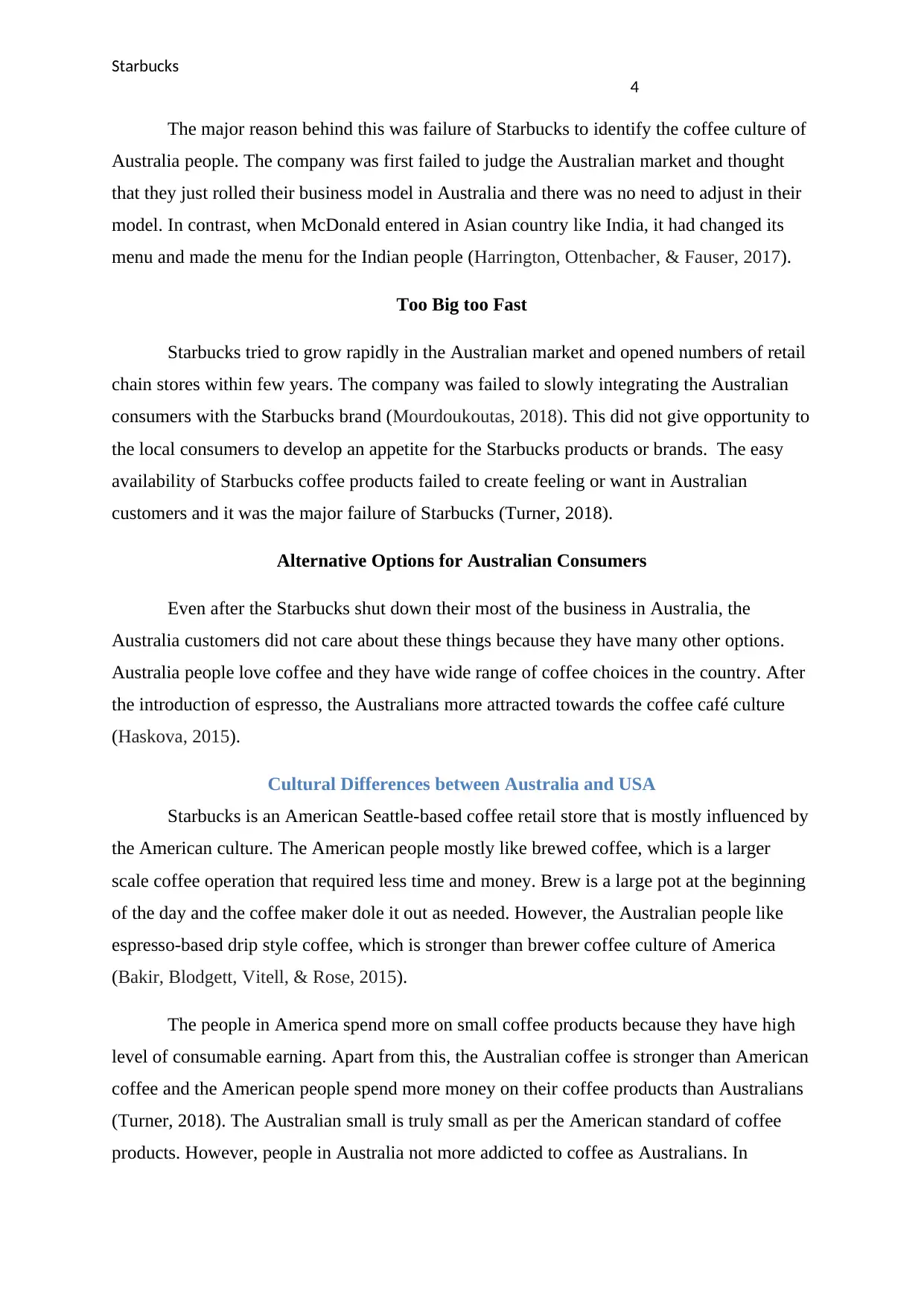
Starbucks
4
The major reason behind this was failure of Starbucks to identify the coffee culture of
Australia people. The company was first failed to judge the Australian market and thought
that they just rolled their business model in Australia and there was no need to adjust in their
model. In contrast, when McDonald entered in Asian country like India, it had changed its
menu and made the menu for the Indian people (Harrington, Ottenbacher, & Fauser, 2017).
Too Big too Fast
Starbucks tried to grow rapidly in the Australian market and opened numbers of retail
chain stores within few years. The company was failed to slowly integrating the Australian
consumers with the Starbucks brand (Mourdoukoutas, 2018). This did not give opportunity to
the local consumers to develop an appetite for the Starbucks products or brands. The easy
availability of Starbucks coffee products failed to create feeling or want in Australian
customers and it was the major failure of Starbucks (Turner, 2018).
Alternative Options for Australian Consumers
Even after the Starbucks shut down their most of the business in Australia, the
Australia customers did not care about these things because they have many other options.
Australia people love coffee and they have wide range of coffee choices in the country. After
the introduction of espresso, the Australians more attracted towards the coffee café culture
(Haskova, 2015).
Cultural Differences between Australia and USA
Starbucks is an American Seattle-based coffee retail store that is mostly influenced by
the American culture. The American people mostly like brewed coffee, which is a larger
scale coffee operation that required less time and money. Brew is a large pot at the beginning
of the day and the coffee maker dole it out as needed. However, the Australian people like
espresso-based drip style coffee, which is stronger than brewer coffee culture of America
(Bakir, Blodgett, Vitell, & Rose, 2015).
The people in America spend more on small coffee products because they have high
level of consumable earning. Apart from this, the Australian coffee is stronger than American
coffee and the American people spend more money on their coffee products than Australians
(Turner, 2018). The Australian small is truly small as per the American standard of coffee
products. However, people in Australia not more addicted to coffee as Australians. In
4
The major reason behind this was failure of Starbucks to identify the coffee culture of
Australia people. The company was first failed to judge the Australian market and thought
that they just rolled their business model in Australia and there was no need to adjust in their
model. In contrast, when McDonald entered in Asian country like India, it had changed its
menu and made the menu for the Indian people (Harrington, Ottenbacher, & Fauser, 2017).
Too Big too Fast
Starbucks tried to grow rapidly in the Australian market and opened numbers of retail
chain stores within few years. The company was failed to slowly integrating the Australian
consumers with the Starbucks brand (Mourdoukoutas, 2018). This did not give opportunity to
the local consumers to develop an appetite for the Starbucks products or brands. The easy
availability of Starbucks coffee products failed to create feeling or want in Australian
customers and it was the major failure of Starbucks (Turner, 2018).
Alternative Options for Australian Consumers
Even after the Starbucks shut down their most of the business in Australia, the
Australia customers did not care about these things because they have many other options.
Australia people love coffee and they have wide range of coffee choices in the country. After
the introduction of espresso, the Australians more attracted towards the coffee café culture
(Haskova, 2015).
Cultural Differences between Australia and USA
Starbucks is an American Seattle-based coffee retail store that is mostly influenced by
the American culture. The American people mostly like brewed coffee, which is a larger
scale coffee operation that required less time and money. Brew is a large pot at the beginning
of the day and the coffee maker dole it out as needed. However, the Australian people like
espresso-based drip style coffee, which is stronger than brewer coffee culture of America
(Bakir, Blodgett, Vitell, & Rose, 2015).
The people in America spend more on small coffee products because they have high
level of consumable earning. Apart from this, the Australian coffee is stronger than American
coffee and the American people spend more money on their coffee products than Australians
(Turner, 2018). The Australian small is truly small as per the American standard of coffee
products. However, people in Australia not more addicted to coffee as Australians. In
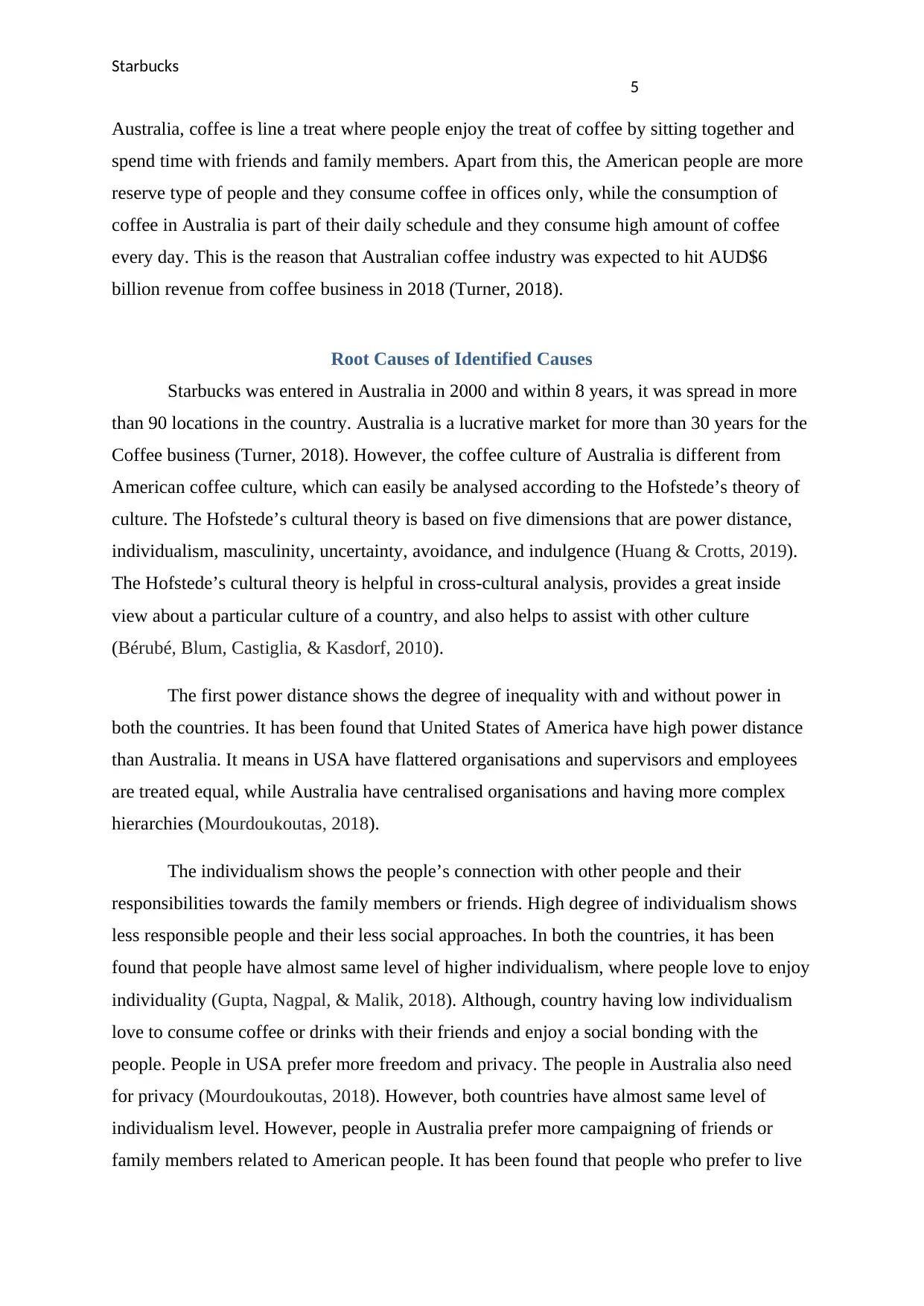
Starbucks
5
Australia, coffee is line a treat where people enjoy the treat of coffee by sitting together and
spend time with friends and family members. Apart from this, the American people are more
reserve type of people and they consume coffee in offices only, while the consumption of
coffee in Australia is part of their daily schedule and they consume high amount of coffee
every day. This is the reason that Australian coffee industry was expected to hit AUD$6
billion revenue from coffee business in 2018 (Turner, 2018).
Root Causes of Identified Causes
Starbucks was entered in Australia in 2000 and within 8 years, it was spread in more
than 90 locations in the country. Australia is a lucrative market for more than 30 years for the
Coffee business (Turner, 2018). However, the coffee culture of Australia is different from
American coffee culture, which can easily be analysed according to the Hofstede’s theory of
culture. The Hofstede’s cultural theory is based on five dimensions that are power distance,
individualism, masculinity, uncertainty, avoidance, and indulgence (Huang & Crotts, 2019).
The Hofstede’s cultural theory is helpful in cross-cultural analysis, provides a great inside
view about a particular culture of a country, and also helps to assist with other culture
(Bérubé, Blum, Castiglia, & Kasdorf, 2010).
The first power distance shows the degree of inequality with and without power in
both the countries. It has been found that United States of America have high power distance
than Australia. It means in USA have flattered organisations and supervisors and employees
are treated equal, while Australia have centralised organisations and having more complex
hierarchies (Mourdoukoutas, 2018).
The individualism shows the people’s connection with other people and their
responsibilities towards the family members or friends. High degree of individualism shows
less responsible people and their less social approaches. In both the countries, it has been
found that people have almost same level of higher individualism, where people love to enjoy
individuality (Gupta, Nagpal, & Malik, 2018). Although, country having low individualism
love to consume coffee or drinks with their friends and enjoy a social bonding with the
people. People in USA prefer more freedom and privacy. The people in Australia also need
for privacy (Mourdoukoutas, 2018). However, both countries have almost same level of
individualism level. However, people in Australia prefer more campaigning of friends or
family members related to American people. It has been found that people who prefer to live
5
Australia, coffee is line a treat where people enjoy the treat of coffee by sitting together and
spend time with friends and family members. Apart from this, the American people are more
reserve type of people and they consume coffee in offices only, while the consumption of
coffee in Australia is part of their daily schedule and they consume high amount of coffee
every day. This is the reason that Australian coffee industry was expected to hit AUD$6
billion revenue from coffee business in 2018 (Turner, 2018).
Root Causes of Identified Causes
Starbucks was entered in Australia in 2000 and within 8 years, it was spread in more
than 90 locations in the country. Australia is a lucrative market for more than 30 years for the
Coffee business (Turner, 2018). However, the coffee culture of Australia is different from
American coffee culture, which can easily be analysed according to the Hofstede’s theory of
culture. The Hofstede’s cultural theory is based on five dimensions that are power distance,
individualism, masculinity, uncertainty, avoidance, and indulgence (Huang & Crotts, 2019).
The Hofstede’s cultural theory is helpful in cross-cultural analysis, provides a great inside
view about a particular culture of a country, and also helps to assist with other culture
(Bérubé, Blum, Castiglia, & Kasdorf, 2010).
The first power distance shows the degree of inequality with and without power in
both the countries. It has been found that United States of America have high power distance
than Australia. It means in USA have flattered organisations and supervisors and employees
are treated equal, while Australia have centralised organisations and having more complex
hierarchies (Mourdoukoutas, 2018).
The individualism shows the people’s connection with other people and their
responsibilities towards the family members or friends. High degree of individualism shows
less responsible people and their less social approaches. In both the countries, it has been
found that people have almost same level of higher individualism, where people love to enjoy
individuality (Gupta, Nagpal, & Malik, 2018). Although, country having low individualism
love to consume coffee or drinks with their friends and enjoy a social bonding with the
people. People in USA prefer more freedom and privacy. The people in Australia also need
for privacy (Mourdoukoutas, 2018). However, both countries have almost same level of
individualism level. However, people in Australia prefer more campaigning of friends or
family members related to American people. It has been found that people who prefer to live
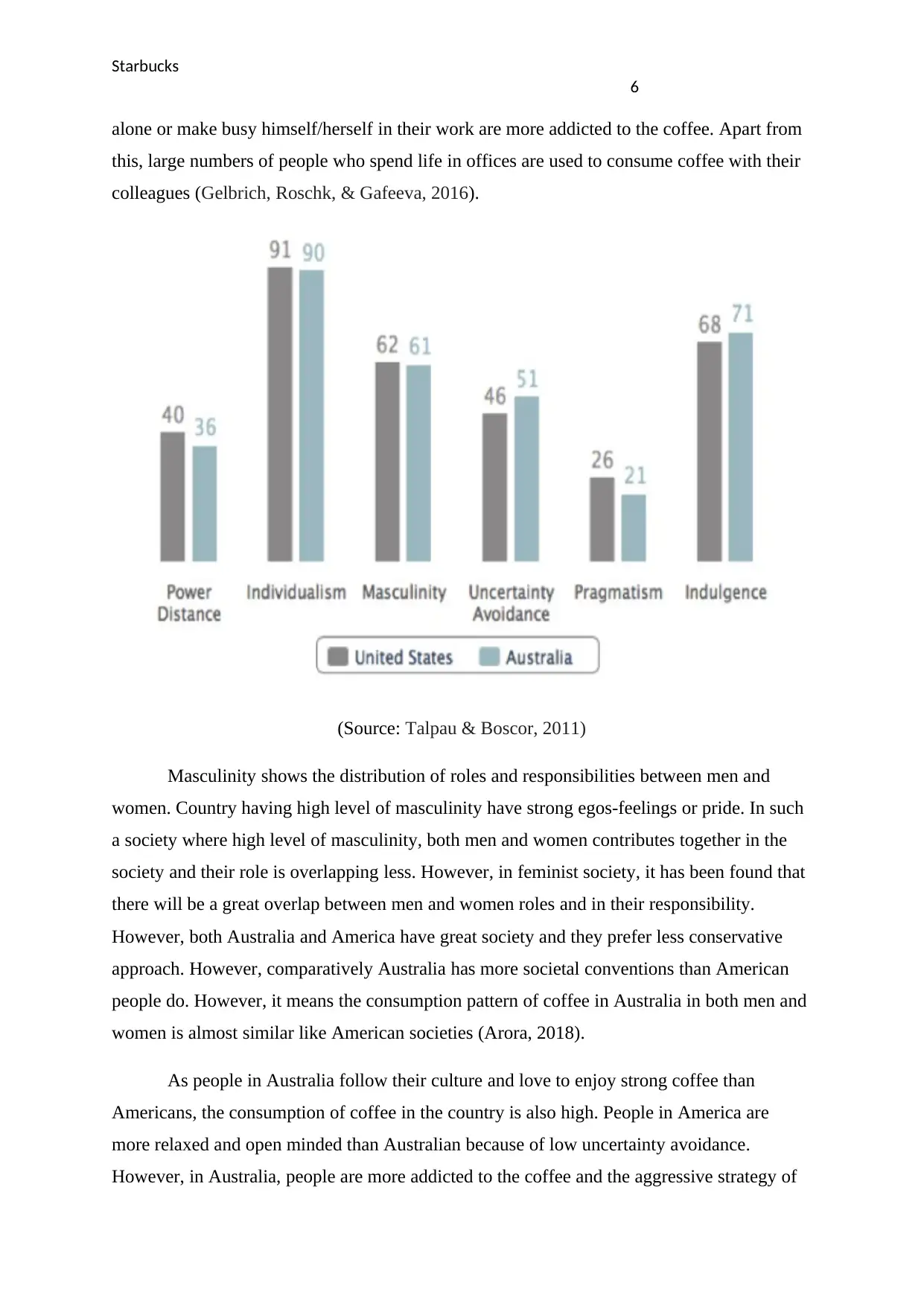
Starbucks
6
alone or make busy himself/herself in their work are more addicted to the coffee. Apart from
this, large numbers of people who spend life in offices are used to consume coffee with their
colleagues (Gelbrich, Roschk, & Gafeeva, 2016).
(Source: Talpau & Boscor, 2011)
Masculinity shows the distribution of roles and responsibilities between men and
women. Country having high level of masculinity have strong egos-feelings or pride. In such
a society where high level of masculinity, both men and women contributes together in the
society and their role is overlapping less. However, in feminist society, it has been found that
there will be a great overlap between men and women roles and in their responsibility.
However, both Australia and America have great society and they prefer less conservative
approach. However, comparatively Australia has more societal conventions than American
people do. However, it means the consumption pattern of coffee in Australia in both men and
women is almost similar like American societies (Arora, 2018).
As people in Australia follow their culture and love to enjoy strong coffee than
Americans, the consumption of coffee in the country is also high. People in America are
more relaxed and open minded than Australian because of low uncertainty avoidance.
However, in Australia, people are more addicted to the coffee and the aggressive strategy of
6
alone or make busy himself/herself in their work are more addicted to the coffee. Apart from
this, large numbers of people who spend life in offices are used to consume coffee with their
colleagues (Gelbrich, Roschk, & Gafeeva, 2016).
(Source: Talpau & Boscor, 2011)
Masculinity shows the distribution of roles and responsibilities between men and
women. Country having high level of masculinity have strong egos-feelings or pride. In such
a society where high level of masculinity, both men and women contributes together in the
society and their role is overlapping less. However, in feminist society, it has been found that
there will be a great overlap between men and women roles and in their responsibility.
However, both Australia and America have great society and they prefer less conservative
approach. However, comparatively Australia has more societal conventions than American
people do. However, it means the consumption pattern of coffee in Australia in both men and
women is almost similar like American societies (Arora, 2018).
As people in Australia follow their culture and love to enjoy strong coffee than
Americans, the consumption of coffee in the country is also high. People in America are
more relaxed and open minded than Australian because of low uncertainty avoidance.
However, in Australia, people are more addicted to the coffee and the aggressive strategy of
Paraphrase This Document
Need a fresh take? Get an instant paraphrase of this document with our AI Paraphraser
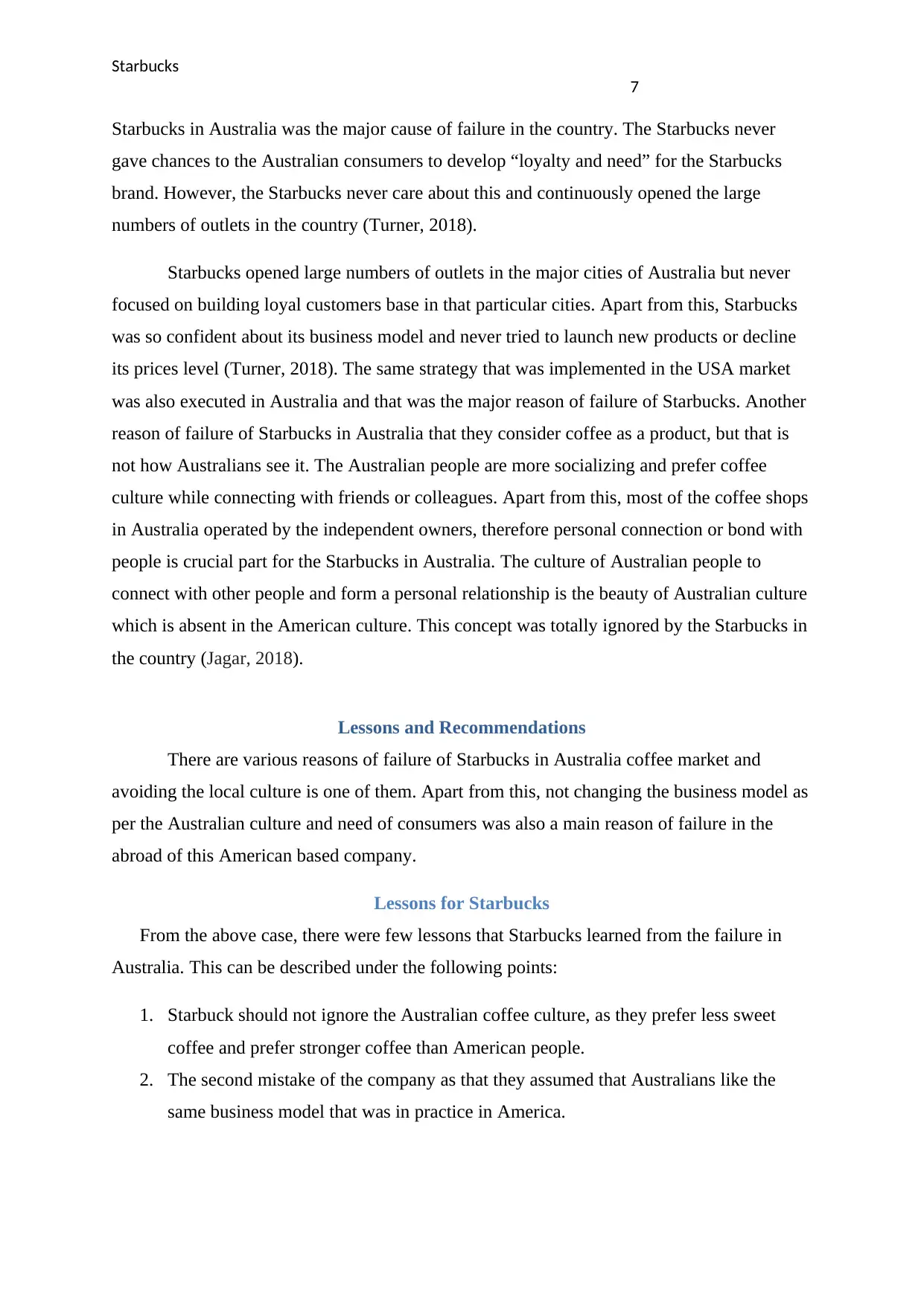
Starbucks
7
Starbucks in Australia was the major cause of failure in the country. The Starbucks never
gave chances to the Australian consumers to develop “loyalty and need” for the Starbucks
brand. However, the Starbucks never care about this and continuously opened the large
numbers of outlets in the country (Turner, 2018).
Starbucks opened large numbers of outlets in the major cities of Australia but never
focused on building loyal customers base in that particular cities. Apart from this, Starbucks
was so confident about its business model and never tried to launch new products or decline
its prices level (Turner, 2018). The same strategy that was implemented in the USA market
was also executed in Australia and that was the major reason of failure of Starbucks. Another
reason of failure of Starbucks in Australia that they consider coffee as a product, but that is
not how Australians see it. The Australian people are more socializing and prefer coffee
culture while connecting with friends or colleagues. Apart from this, most of the coffee shops
in Australia operated by the independent owners, therefore personal connection or bond with
people is crucial part for the Starbucks in Australia. The culture of Australian people to
connect with other people and form a personal relationship is the beauty of Australian culture
which is absent in the American culture. This concept was totally ignored by the Starbucks in
the country (Jagar, 2018).
Lessons and Recommendations
There are various reasons of failure of Starbucks in Australia coffee market and
avoiding the local culture is one of them. Apart from this, not changing the business model as
per the Australian culture and need of consumers was also a main reason of failure in the
abroad of this American based company.
Lessons for Starbucks
From the above case, there were few lessons that Starbucks learned from the failure in
Australia. This can be described under the following points:
1. Starbuck should not ignore the Australian coffee culture, as they prefer less sweet
coffee and prefer stronger coffee than American people.
2. The second mistake of the company as that they assumed that Australians like the
same business model that was in practice in America.
7
Starbucks in Australia was the major cause of failure in the country. The Starbucks never
gave chances to the Australian consumers to develop “loyalty and need” for the Starbucks
brand. However, the Starbucks never care about this and continuously opened the large
numbers of outlets in the country (Turner, 2018).
Starbucks opened large numbers of outlets in the major cities of Australia but never
focused on building loyal customers base in that particular cities. Apart from this, Starbucks
was so confident about its business model and never tried to launch new products or decline
its prices level (Turner, 2018). The same strategy that was implemented in the USA market
was also executed in Australia and that was the major reason of failure of Starbucks. Another
reason of failure of Starbucks in Australia that they consider coffee as a product, but that is
not how Australians see it. The Australian people are more socializing and prefer coffee
culture while connecting with friends or colleagues. Apart from this, most of the coffee shops
in Australia operated by the independent owners, therefore personal connection or bond with
people is crucial part for the Starbucks in Australia. The culture of Australian people to
connect with other people and form a personal relationship is the beauty of Australian culture
which is absent in the American culture. This concept was totally ignored by the Starbucks in
the country (Jagar, 2018).
Lessons and Recommendations
There are various reasons of failure of Starbucks in Australia coffee market and
avoiding the local culture is one of them. Apart from this, not changing the business model as
per the Australian culture and need of consumers was also a main reason of failure in the
abroad of this American based company.
Lessons for Starbucks
From the above case, there were few lessons that Starbucks learned from the failure in
Australia. This can be described under the following points:
1. Starbuck should not ignore the Australian coffee culture, as they prefer less sweet
coffee and prefer stronger coffee than American people.
2. The second mistake of the company as that they assumed that Australians like the
same business model that was in practice in America.
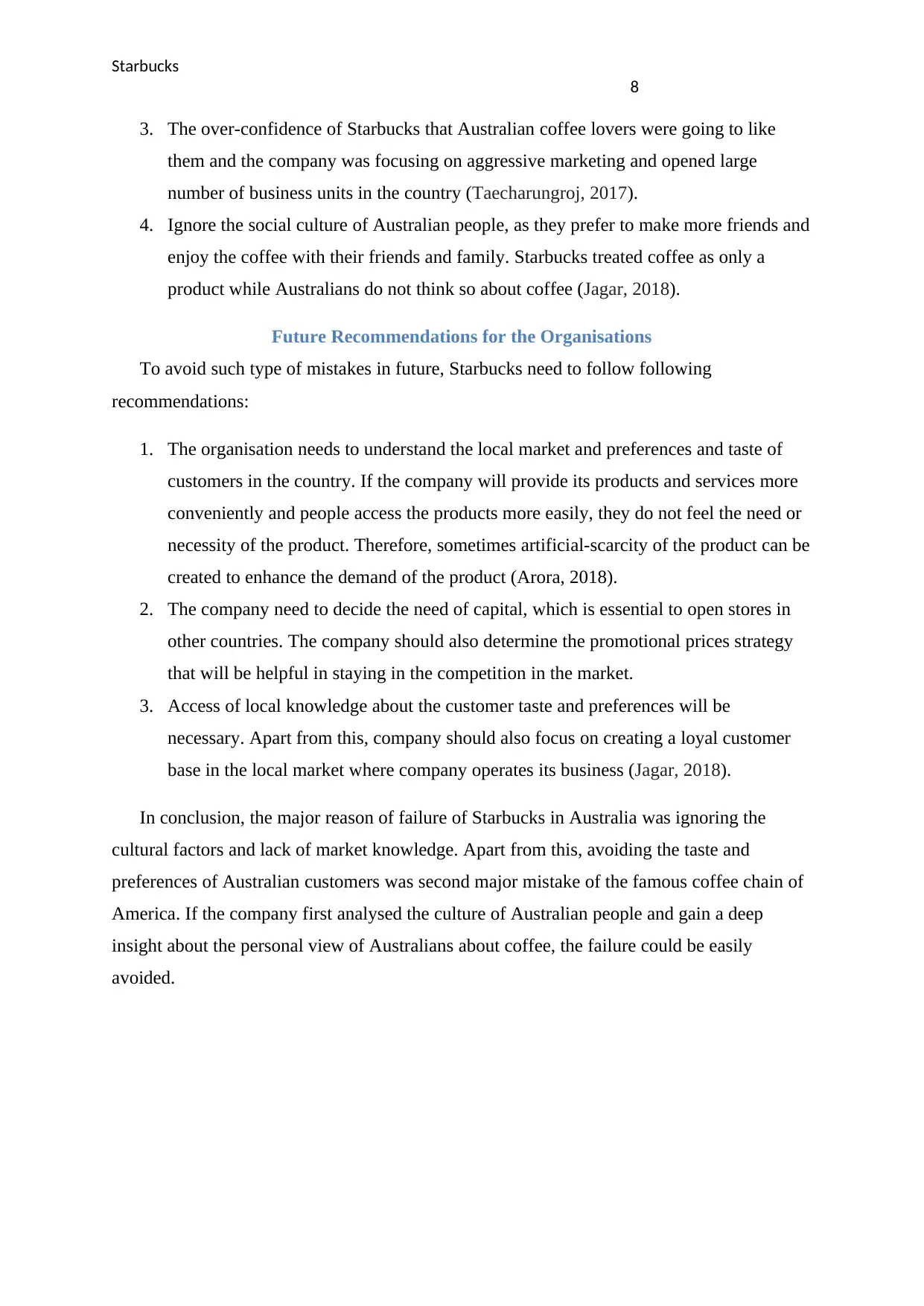
Starbucks
8
3. The over-confidence of Starbucks that Australian coffee lovers were going to like
them and the company was focusing on aggressive marketing and opened large
number of business units in the country (Taecharungroj, 2017).
4. Ignore the social culture of Australian people, as they prefer to make more friends and
enjoy the coffee with their friends and family. Starbucks treated coffee as only a
product while Australians do not think so about coffee (Jagar, 2018).
Future Recommendations for the Organisations
To avoid such type of mistakes in future, Starbucks need to follow following
recommendations:
1. The organisation needs to understand the local market and preferences and taste of
customers in the country. If the company will provide its products and services more
conveniently and people access the products more easily, they do not feel the need or
necessity of the product. Therefore, sometimes artificial-scarcity of the product can be
created to enhance the demand of the product (Arora, 2018).
2. The company need to decide the need of capital, which is essential to open stores in
other countries. The company should also determine the promotional prices strategy
that will be helpful in staying in the competition in the market.
3. Access of local knowledge about the customer taste and preferences will be
necessary. Apart from this, company should also focus on creating a loyal customer
base in the local market where company operates its business (Jagar, 2018).
In conclusion, the major reason of failure of Starbucks in Australia was ignoring the
cultural factors and lack of market knowledge. Apart from this, avoiding the taste and
preferences of Australian customers was second major mistake of the famous coffee chain of
America. If the company first analysed the culture of Australian people and gain a deep
insight about the personal view of Australians about coffee, the failure could be easily
avoided.
8
3. The over-confidence of Starbucks that Australian coffee lovers were going to like
them and the company was focusing on aggressive marketing and opened large
number of business units in the country (Taecharungroj, 2017).
4. Ignore the social culture of Australian people, as they prefer to make more friends and
enjoy the coffee with their friends and family. Starbucks treated coffee as only a
product while Australians do not think so about coffee (Jagar, 2018).
Future Recommendations for the Organisations
To avoid such type of mistakes in future, Starbucks need to follow following
recommendations:
1. The organisation needs to understand the local market and preferences and taste of
customers in the country. If the company will provide its products and services more
conveniently and people access the products more easily, they do not feel the need or
necessity of the product. Therefore, sometimes artificial-scarcity of the product can be
created to enhance the demand of the product (Arora, 2018).
2. The company need to decide the need of capital, which is essential to open stores in
other countries. The company should also determine the promotional prices strategy
that will be helpful in staying in the competition in the market.
3. Access of local knowledge about the customer taste and preferences will be
necessary. Apart from this, company should also focus on creating a loyal customer
base in the local market where company operates its business (Jagar, 2018).
In conclusion, the major reason of failure of Starbucks in Australia was ignoring the
cultural factors and lack of market knowledge. Apart from this, avoiding the taste and
preferences of Australian customers was second major mistake of the famous coffee chain of
America. If the company first analysed the culture of Australian people and gain a deep
insight about the personal view of Australians about coffee, the failure could be easily
avoided.
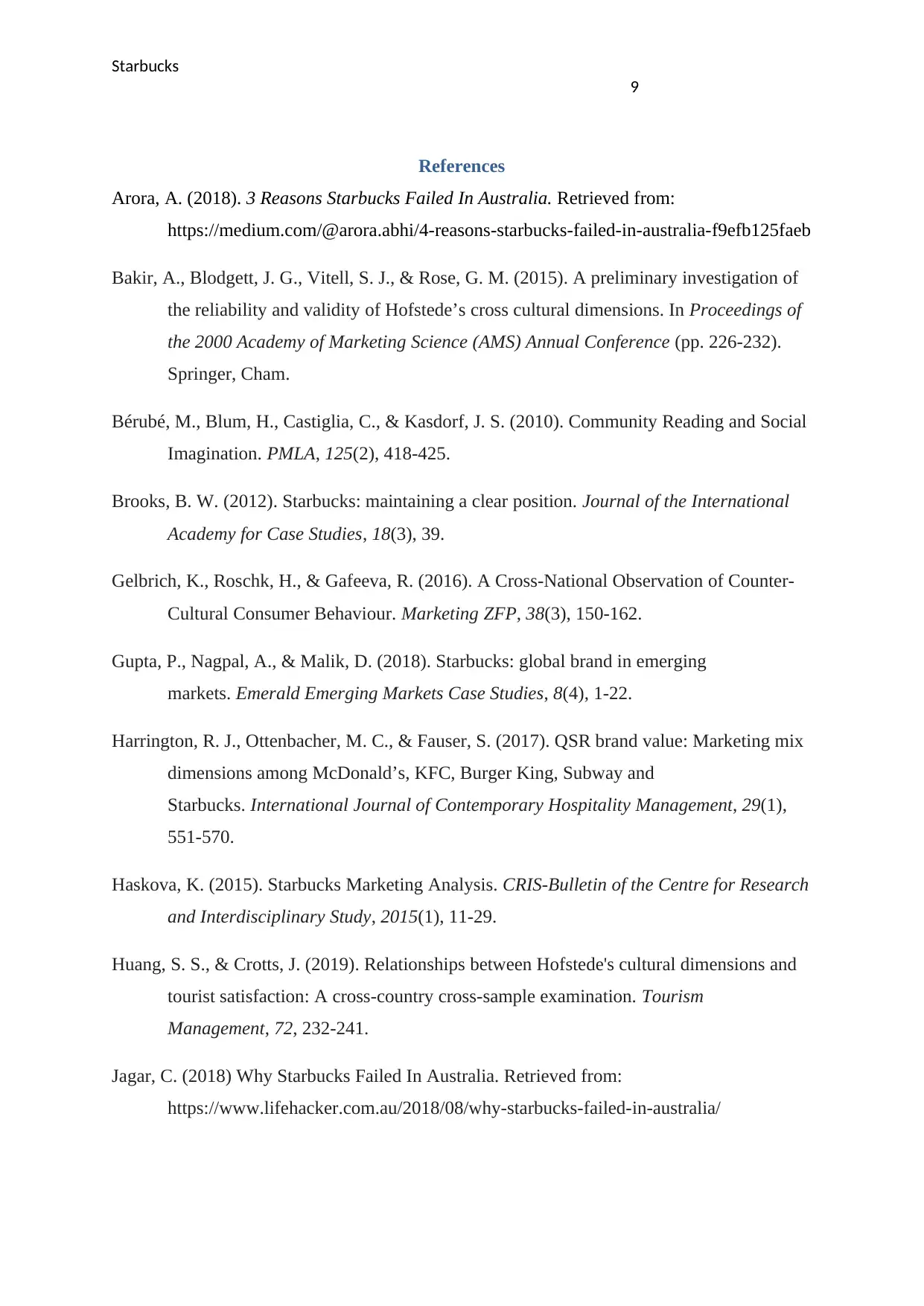
Starbucks
9
References
Arora, A. (2018). 3 Reasons Starbucks Failed In Australia. Retrieved from:
https://medium.com/@arora.abhi/4-reasons-starbucks-failed-in-australia-f9efb125faeb
Bakir, A., Blodgett, J. G., Vitell, S. J., & Rose, G. M. (2015). A preliminary investigation of
the reliability and validity of Hofstede’s cross cultural dimensions. In Proceedings of
the 2000 Academy of Marketing Science (AMS) Annual Conference (pp. 226-232).
Springer, Cham.
Bérubé, M., Blum, H., Castiglia, C., & Kasdorf, J. S. (2010). Community Reading and Social
Imagination. PMLA, 125(2), 418-425.
Brooks, B. W. (2012). Starbucks: maintaining a clear position. Journal of the International
Academy for Case Studies, 18(3), 39.
Gelbrich, K., Roschk, H., & Gafeeva, R. (2016). A Cross-National Observation of Counter-
Cultural Consumer Behaviour. Marketing ZFP, 38(3), 150-162.
Gupta, P., Nagpal, A., & Malik, D. (2018). Starbucks: global brand in emerging
markets. Emerald Emerging Markets Case Studies, 8(4), 1-22.
Harrington, R. J., Ottenbacher, M. C., & Fauser, S. (2017). QSR brand value: Marketing mix
dimensions among McDonald’s, KFC, Burger King, Subway and
Starbucks. International Journal of Contemporary Hospitality Management, 29(1),
551-570.
Haskova, K. (2015). Starbucks Marketing Analysis. CRIS-Bulletin of the Centre for Research
and Interdisciplinary Study, 2015(1), 11-29.
Huang, S. S., & Crotts, J. (2019). Relationships between Hofstede's cultural dimensions and
tourist satisfaction: A cross-country cross-sample examination. Tourism
Management, 72, 232-241.
Jagar, C. (2018) Why Starbucks Failed In Australia. Retrieved from:
https://www.lifehacker.com.au/2018/08/why-starbucks-failed-in-australia/
9
References
Arora, A. (2018). 3 Reasons Starbucks Failed In Australia. Retrieved from:
https://medium.com/@arora.abhi/4-reasons-starbucks-failed-in-australia-f9efb125faeb
Bakir, A., Blodgett, J. G., Vitell, S. J., & Rose, G. M. (2015). A preliminary investigation of
the reliability and validity of Hofstede’s cross cultural dimensions. In Proceedings of
the 2000 Academy of Marketing Science (AMS) Annual Conference (pp. 226-232).
Springer, Cham.
Bérubé, M., Blum, H., Castiglia, C., & Kasdorf, J. S. (2010). Community Reading and Social
Imagination. PMLA, 125(2), 418-425.
Brooks, B. W. (2012). Starbucks: maintaining a clear position. Journal of the International
Academy for Case Studies, 18(3), 39.
Gelbrich, K., Roschk, H., & Gafeeva, R. (2016). A Cross-National Observation of Counter-
Cultural Consumer Behaviour. Marketing ZFP, 38(3), 150-162.
Gupta, P., Nagpal, A., & Malik, D. (2018). Starbucks: global brand in emerging
markets. Emerald Emerging Markets Case Studies, 8(4), 1-22.
Harrington, R. J., Ottenbacher, M. C., & Fauser, S. (2017). QSR brand value: Marketing mix
dimensions among McDonald’s, KFC, Burger King, Subway and
Starbucks. International Journal of Contemporary Hospitality Management, 29(1),
551-570.
Haskova, K. (2015). Starbucks Marketing Analysis. CRIS-Bulletin of the Centre for Research
and Interdisciplinary Study, 2015(1), 11-29.
Huang, S. S., & Crotts, J. (2019). Relationships between Hofstede's cultural dimensions and
tourist satisfaction: A cross-country cross-sample examination. Tourism
Management, 72, 232-241.
Jagar, C. (2018) Why Starbucks Failed In Australia. Retrieved from:
https://www.lifehacker.com.au/2018/08/why-starbucks-failed-in-australia/
Secure Best Marks with AI Grader
Need help grading? Try our AI Grader for instant feedback on your assignments.
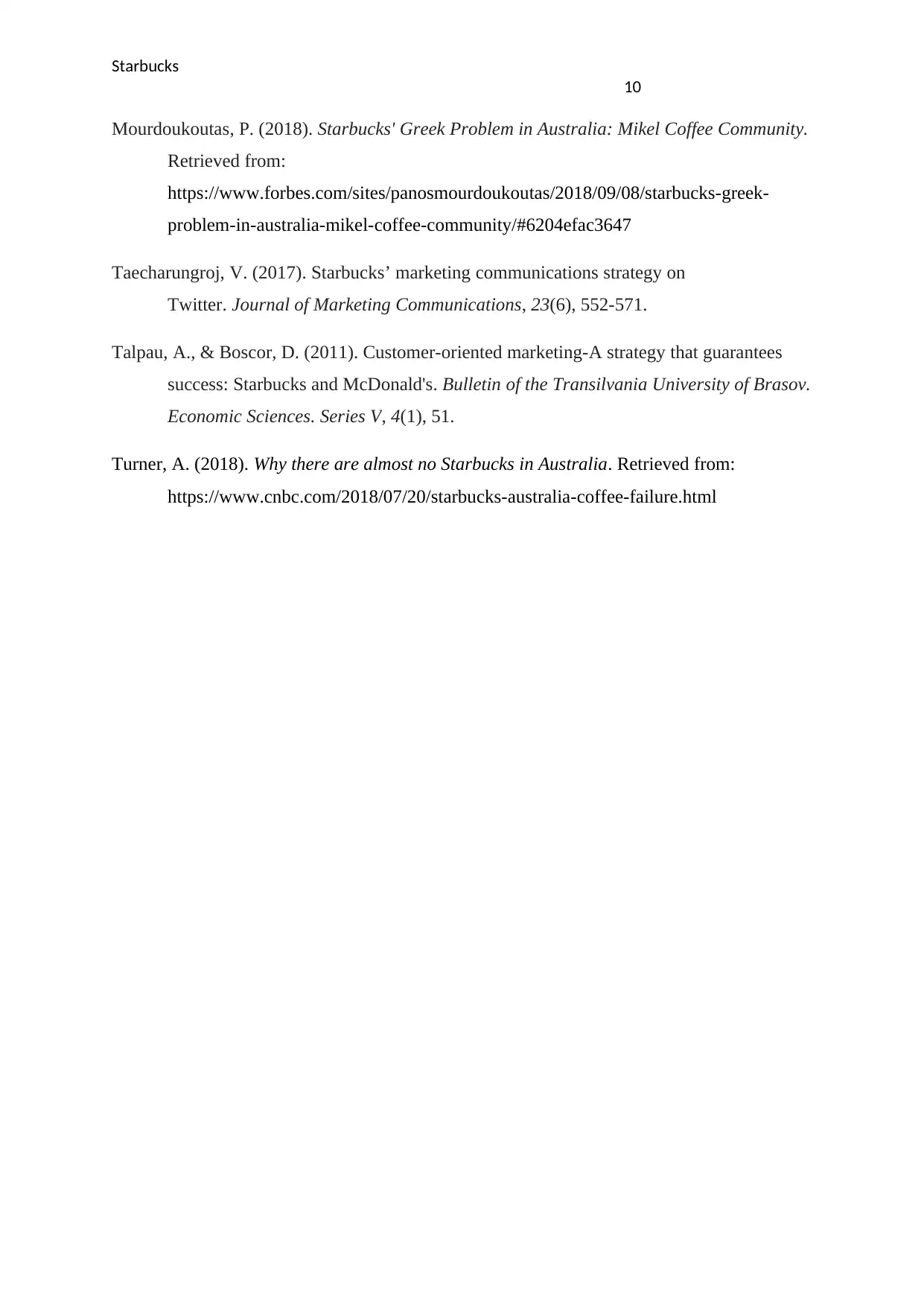
Starbucks
10
Mourdoukoutas, P. (2018). Starbucks' Greek Problem in Australia: Mikel Coffee Community.
Retrieved from:
https://www.forbes.com/sites/panosmourdoukoutas/2018/09/08/starbucks-greek-
problem-in-australia-mikel-coffee-community/#6204efac3647
Taecharungroj, V. (2017). Starbucks’ marketing communications strategy on
Twitter. Journal of Marketing Communications, 23(6), 552-571.
Talpau, A., & Boscor, D. (2011). Customer-oriented marketing-A strategy that guarantees
success: Starbucks and McDonald's. Bulletin of the Transilvania University of Brasov.
Economic Sciences. Series V, 4(1), 51.
Turner, A. (2018). Why there are almost no Starbucks in Australia. Retrieved from:
https://www.cnbc.com/2018/07/20/starbucks-australia-coffee-failure.html
10
Mourdoukoutas, P. (2018). Starbucks' Greek Problem in Australia: Mikel Coffee Community.
Retrieved from:
https://www.forbes.com/sites/panosmourdoukoutas/2018/09/08/starbucks-greek-
problem-in-australia-mikel-coffee-community/#6204efac3647
Taecharungroj, V. (2017). Starbucks’ marketing communications strategy on
Twitter. Journal of Marketing Communications, 23(6), 552-571.
Talpau, A., & Boscor, D. (2011). Customer-oriented marketing-A strategy that guarantees
success: Starbucks and McDonald's. Bulletin of the Transilvania University of Brasov.
Economic Sciences. Series V, 4(1), 51.
Turner, A. (2018). Why there are almost no Starbucks in Australia. Retrieved from:
https://www.cnbc.com/2018/07/20/starbucks-australia-coffee-failure.html
1 out of 11
Related Documents
Your All-in-One AI-Powered Toolkit for Academic Success.
+13062052269
info@desklib.com
Available 24*7 on WhatsApp / Email
![[object Object]](/_next/static/media/star-bottom.7253800d.svg)
Unlock your academic potential
© 2024 | Zucol Services PVT LTD | All rights reserved.





